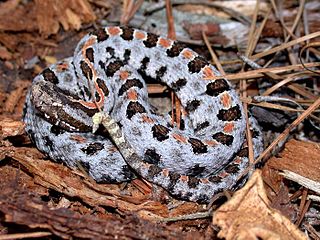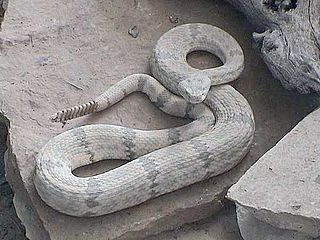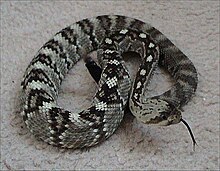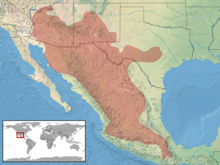
The sidewinder, also known as the horned rattlesnake and sidewinder rattlesnake, is a venomous pit viper species belonging to the genus Crotalus (rattlesnakes) and is found in the desert regions of the southwestern United States and northwestern Mexico. The sidewinder reaches speeds of up to 18 mph. Three subspecies are currently recognized.

Sistrurus is a genus of venomous pit vipers in the subfamily Crotalinae of the family Viperidae. The genus is endemic to Canada, the United States, and Mexico. The generic name is a Latinized form of the Greek word for "tail rattler" and shares its root with the ancient Egyptian musical instrument, the sistrum, a type of rattle. Three species are currently recognized.

Crotalus scutulatus is a highly venomous pit viper species found in the deserts of the southwestern United States and central Mexico. It is perhaps best known for its potent neurotoxic-hemotoxic venom, which is considered one of the world's most potent rattlesnake venoms. Two subspecies are recognized, including the nominate subspecies described here.

The timber rattlesnake, canebrake rattlesnake or banded rattlesnake, is a species of venomous pit viper endemic to eastern North America. This is the only rattlesnake species in most of the populous northeastern United States and is second only to its cousins to the west, the prairie rattlesnake, as the most northerly distributed venomous snake in North America. No subspecies are currently recognized.

The eastern diamondback rattlesnake is a species of venomous pit viper in the family Viperidae. The species is endemic to the southeastern United States. It is one of the heaviest venomous snakes in the Americas and the largest rattlesnake. No subspecies are recognized.

Crotalus lepidus is a venomous pit viper species found in the southwestern United States and northern central Mexico. Four subspecies are currently recognized, including the nominate subspecies described here.

Crotalus basiliscus is a venomous pit viper species in the family Viperidae. The species is endemic to western Mexico. The specific name, basiliscus, is derived from the Greek word for king, βασιλισκος (basiliskos), and alludes to this snake's large size and potent venom. There are no subspecies which are recognized as being valid.

Crotalus helleri is a highly venomous pit viper subspecies found in southwestern California and south into Baja California, Mexico.

The western diamondback rattlesnake or Texas diamond-back is a venomous rattlesnake species found in the southwestern United States and Mexico. It is likely responsible for the majority of snakebite fatalities in northern Mexico and the greatest number of snakebites in the U.S. No subspecies are currently recognized.

Crotalus viridis is a venomous pit viper species native to the western United States, southwestern Canada, and northern Mexico. Currently, two subspecies are recognized, including the nominate subspecies described here.

Crotalus mitchellii is a venomous pit viper species in the family Viperidae. The species is endemic to the Southwestern United States and adjacent northern Mexico. The species was named in honor of Silas Weir Mitchell (1829–1914), an American medical doctor who also studied rattlesnake venoms. Five subspecies are currently recognized, including the nominate subspecies described here.

The Santa Catalina rattlesnake is a species of venomous pit viper endemic to Isla Santa Catalina in the Gulf of California just off the east coast of the state of Baja California Sur, Mexico. No subspecies are currently recognized. A relatively small and slender species, its most distinctive characteristic is that it lacks a rattle.

Sistrurus miliarius, commonly called the pygmy rattlesnake, is a species of venomous snake in the subfamily Crotalinae of the family Viperidae. The species is endemic to the Southeastern United States. Three subspecies are currently recognized, including the nominate subspecies described here.

Crotalus viridis nuntius is a venomous pit viper subspecies native primarily to the desert plateau of the northeastern portion of the American state of Arizona, but also ranges into northwestern New Mexico. Named for the Native American Hopi tribe, which inhabits the region, its range overlaps that of the nominate subspecies and some interbreeding is believed to occur. The taxonomy of the C. viridis group is a matter of debate, many considering the various subspecies to be nothing more than locality variations.

Crotalus oreganus is a venomous pit viper species found in North America in the western United States, and parts of British Columbia.

Crotalus atrox tortugensis is a venomous pit viper subspecies found only on Tortuga Island in the Gulf of California.

The tiger rattlesnake is a highly venomous pit viper species found in the southwestern United States and northwestern Mexico. No subspecies are currently recognized. The specific name tigris, Latin for "tiger", refers to the many narrow dorsal crossbands, which create a pattern of vertical stripes when viewed from the side.

Crotalus pricei is a species of venomous snake, a pit viper in the family Viperidae. The species is endemic to the southwestern United States and northern Mexico. Two subspecies are recognized, including the nominate subspecies described here.

Crotalus lannomi, known commonly as the Autlán rattlesnake, is a species of venomous snake, a pit viper in the family Viperidae. The species is endemic to southwestern Mexico. There are no subspecies that are recognized as being valid.

Crotalus stejnegeri is a venomous pit viper species in the family Viperidae. The species is native to western Mexico. There are no recognized subspecies.























